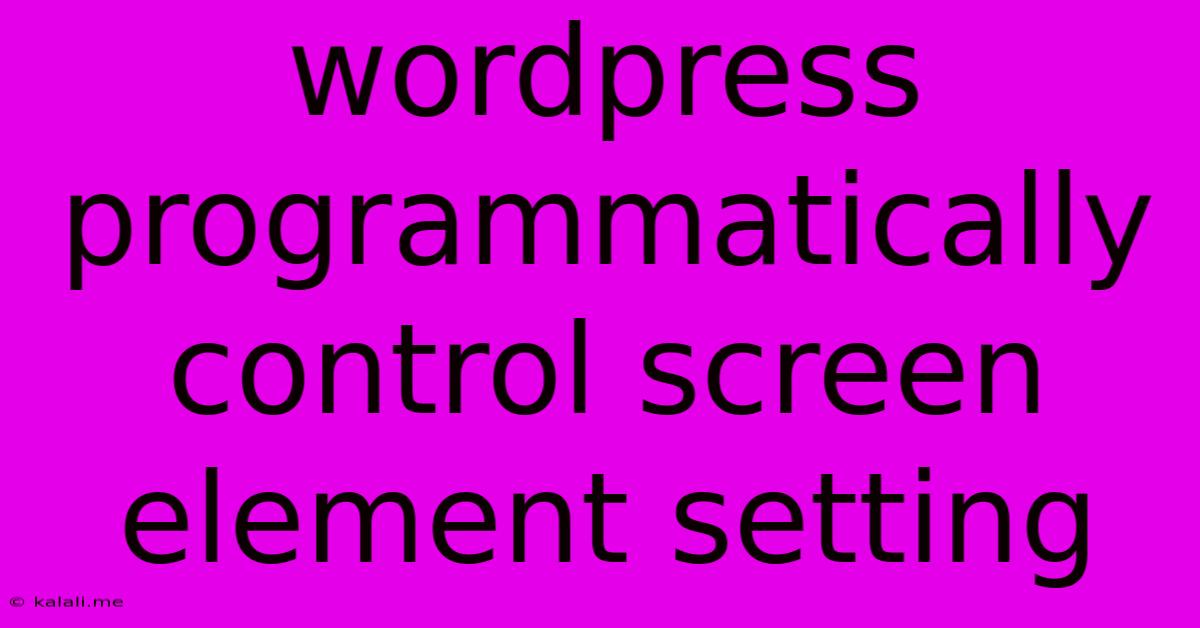Wordpress Programmatically Control Screen Element Setting
Kalali
May 30, 2025 · 3 min read

Table of Contents
Programmatically Controlling WordPress Screen Element Settings: A Developer's Guide
This article delves into the powerful techniques for programmatically controlling screen element settings within the WordPress administration interface. We'll explore how to manage column visibility, screen options, and other aspects to tailor the admin experience for users, enhancing efficiency and productivity. Understanding these methods is crucial for plugin and theme developers seeking to refine the backend for specific user roles or functionalities.
Understanding WordPress Screen Options
Before diving into programmatic control, it's essential to understand how WordPress manages screen options. Many admin screens offer a "Screen Options" tab, allowing users to customize what elements are displayed. These options are stored as user meta, tied to the specific screen ID. Programmatic control allows us to interact with and modify this meta data, thereby customizing the screen layout without direct user interaction.
This is vital for several reasons:
- Improved User Experience: Tailor the admin area to show only the most relevant information for specific user roles, reducing clutter and improving efficiency.
- Enhanced Security: Hide sensitive information from users who don't need access to it.
- Custom Workflows: Streamline workflows by pre-configuring screen settings for specific tasks or users.
- Plugin and Theme Development: Create a seamless and intuitive admin experience for your plugin or theme users.
Key Functions and Techniques
WordPress provides several functions to achieve programmatic control over screen elements. Here are some of the most useful:
-
add_screen_option(): This function allows you to add custom screen options to existing admin screens. You specify the option's title, type (e.g., checkbox, dropdown), and default value. This is useful for expanding existing screen functionality. -
remove_screen_option(): This removes existing screen options, offering a way to declutter the interface and hide unnecessary settings. -
get_user_option(): Retrieve a user's saved screen options for a given screen ID. This enables you to access the current settings and potentially tailor your plugin's behaviour based on user preferences. -
add_filter( 'manage_posts_columns', ... ): This powerful filter allows modification of column visibility on post and custom post type list screens. By manipulating the array returned by this filter, you can add, remove, reorder, or rename columns. Similar filters exist for other admin screens, like the taxonomy management screens. -
add_filter( 'manage_edit-post_type_columns', ... ): This filter is specifically designed for controlling columns on custom post type screens. Replacepost_typewith the actual slug of your custom post type. -
add_filter( 'screen_layout_columns', ... ): This filter lets you modify the number of columns displayed for different screen layouts (e.g., single-column or two-column view). -
Conditional Logic and User Roles: Employing conditional logic (
if/elsestatements) and checking user roles usingcurrent_user_can()allows you to apply specific screen adjustments based on user privileges and context. This prevents unintended access to certain features or settings.
Practical Examples
Let's illustrate with a couple of simple examples:
Example 1: Hiding a Column in the Posts List:
add_filter( 'manage_posts_columns', 'my_custom_columns' );
function my_custom_columns( $columns ) {
unset( $columns['author'] ); // Remove the 'Author' column
return $columns;
}
Example 2: Adding a Custom Screen Option:
add_action( 'add_meta_boxes', 'add_custom_screen_option' );
function add_custom_screen_option() {
add_screen_option( 'my_custom_option', array(
'label' => __( 'My Custom Option' ),
'default' => 'on', // Default value
'type' => 'checkbox'
) );
}
Remember to always thoroughly test your code to ensure it functions correctly and doesn't cause unintended consequences. Pay close attention to the specific screen ID you're targeting to avoid conflicts.
Conclusion
Programmatically managing screen element settings in WordPress empowers developers to craft highly customized and user-friendly admin experiences. By carefully utilizing the available functions and filters, you can significantly improve the efficiency and intuitiveness of the WordPress backend for users of your plugins and themes. Remember to prioritize clear, well-documented code to facilitate maintainability and future development.
Latest Posts
Latest Posts
-
1 Lemon Equals How Much Lemon Juice
May 31, 2025
-
Hidden Half Wall Secure Storage Half Wall
May 31, 2025
-
How To Figure Voltage Drop Across A Resistor
May 31, 2025
-
How To Replay Campaign Destiny 2 Final Shape
May 31, 2025
-
Can You Use Atf As Power Steering Fluid
May 31, 2025
Related Post
Thank you for visiting our website which covers about Wordpress Programmatically Control Screen Element Setting . We hope the information provided has been useful to you. Feel free to contact us if you have any questions or need further assistance. See you next time and don't miss to bookmark.